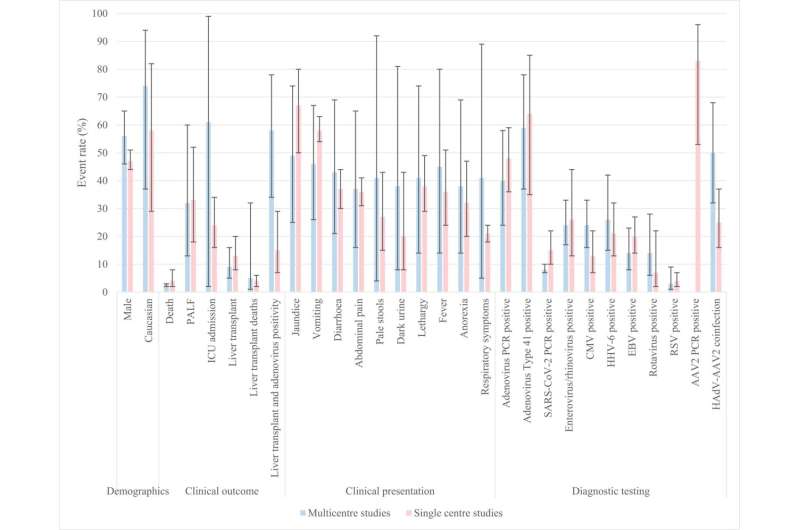This article has been reviewed according to Science X's editorial process and policies. Editors have highlighted the following attributes while ensuring the content's credibility:
fact-checked
trusted source
proofread
Study examines medical mystery of child hepatitis outbreak

An analysis of the sudden global outbreak of hepatitis in children finds that although the primary suspect is highly likely to be an infection by multiple viruses, many questions still puzzle researchers.
The University of Sydney study has shed more light on an unexpected wave of severe hepatitis cases in 2022, amid the backdrop of an ongoing global COVID-19 pandemic.
The outbreak affected only children under the age of 10, and, within a year, more than 1,000 children from 35 countries with hepatitis of unknown origin were reported to the World Health Organization. But in 12 months, cases seemed to stop just as quickly as they appeared.
The study found current medical evidence supports an existing theory that the mysterious hepatitis was caused by an infection of different viruses at the same time, but also reveals cases were higher and more severe than initially thought.
Hepatitis is inflammation of the liver, which can result in liver failure. Of the reported cases, 6% of children required liver transplants.
However, inconsistent surveillance and monitoring by health agencies means that questions around the outbreak are only half-answered, including why cases were reported only in certain countries.
For instance, the first reported cases were in the U.K., and then the U.S., particularly in the state of Alabama. However, there was no clear link that could explain how the outbreak crossed continents.
"When the outbreak unfolded, the increase of cases was baffling, it was intriguing as to how these cases occurred and why there were cases from the United Kingdom as well as cases from the United States," says co-author Professor Guy Eslick from the Australian Pediatric Surveillance Unit at the University of Sydney.
"It was a medical mystery we wanted to investigate. In this study by bringing together all available evidence, we can form a clearer picture about the cause of the outbreak. This will be crucial for the identification and prevention of future outbreaks," says Professor Eslick.
The team pooled evidence from all available studies reporting on cases of hepatitis of unknown origin, where doctors were unable to determine the cause.
The team found that the number of cases was higher and more severe than initially thought, with the data covering 33 reports and more than 3,000 cases. The mortality rate was 3.5%.
There was also strong evidence supporting a leading theory that hepatitis was caused by infection of different viruses at the same time.
A common childhood virus called adeno-associated virus 2 (AAV2) was present in blood and tissue samples from the majority of children with unexplained hepatitis, and many were infected by multiple "helper viruses."
AAV2 cannot multiply unless there is a "helper virus" to kickstart the infection, which can include other common childhood respiratory and enteric (related to the intestine) disease causing agents, such as adenovirus, enterovirus, rhinovirus (common cold) and herpes viruses. In some patient samples, SARS-CoV-2 was detected.
The timing of the outbreak and the COVID-19 pandemic potentially also had a role. After COVID-19 pandemic restrictions were lifted, young children who had been isolated had immune systems less trained to fight off common childhood infections.
But many questions continue to puzzle researchers. These include how the outbreak appeared, and if there could be a genetic link that made some children more vulnerable in developing severe hepatitis than others.
Another question is why certain countries were major epicenters of the outbreak, with cases concentrated in the U.K. and U.S. Although there were cases in New Zealand, there were no cases in Australia.
The findings were published in the Journal of Infection.
Study an important lesson in disease surveillance
Although the study offers a clearer picture of the outbreak, Professor Eslick says our understanding of the 2022 hepatitis of unknown origin outbreak is still incomplete.
Professor Eslick says there was also inconsistent reporting and surveillance of the outbreak between countries already under pressure managing the COVID-19 pandemic.
When reports of a strange hepatitis outbreak in children reached Professor Eslick and his team at the Australia Pediatric Surveillance Unit in May 2022, they immediately began monitoring for cases in Australia.
"Global disease surveillance provides an invaluable network for researchers and medical professionals to monitor and share information on emerging disease outbreaks—so we can be better prepared," he says.
Professor Eslick was in constant contact with both the U.S.-based Centers for Disease Control and Prevention (CDC) and the European Center of Disease Control for regular updates.
The Australian Pediatric Surveillance Unit is continuing to monitor for hepatitis cases of unknown origin. They have been monitoring all cases of severe acute hepatitis in children and adolescents, not just the unknown cases. However, Professor Eslick said further research is required.
Since the 2022 outbreak, monitoring by many health agencies such as the CDC for similar hepatitis cases in children has stopped.
"The lesson from all past and present disease outbreaks is the need to be continually vigilant. This is something we need to continue investigating," Professor Eslick says.
More information: Julie Phan et al, Demystifying the global outbreak of severe acute hepatitis of unknown aetiology in children: A systematic review and meta-analysis, Journal of Infection (2023). DOI: 10.1016/j.jinf.2023.11.011



















